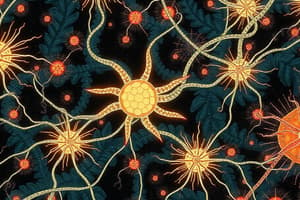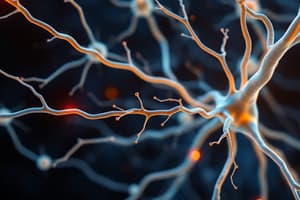Podcast
Questions and Answers
What is the primary function of afferent neurons in the sensory pathway?
What is the primary function of afferent neurons in the sensory pathway?
- To send signals away from the central nervous system
- To mediate responses in the autonomic nervous system
- To transmit sensory information to the central nervous system (correct)
- To control motor functions in the body
What characterizes a positive feedback mechanism in neural activity?
What characterizes a positive feedback mechanism in neural activity?
- It balances the sympathetic and parasympathetic responses
- It regulates energy consumption in the body
- It inhibits further responses to a stimulus
- It amplifies the original stimulus (correct)
Which of the following correctly describes the function of the sympathetic nervous system?
Which of the following correctly describes the function of the sympathetic nervous system?
- It prepares the body for fight or flight (correct)
- It enhances sensory perception
- It promotes rest and digestion
- It decreases heart rate and respiration
What occurs at the threshold in neural signaling?
What occurs at the threshold in neural signaling?
Which of the following statements about efferent neurons is true?
Which of the following statements about efferent neurons is true?
Flashcards are hidden until you start studying
Study Notes
Nervous System Organization
- Nerves are groups of neurons that transmit signals throughout the body.
- Sensory neurons transmit signals from the body to the brain.
- Efferent neurons transmit signals from the brain to the body.
Neurons
-
Neurons are the basic unit of the nervous system.
-
Neurons communicate with each other through action potentials.
-
Action potentials are electrical signals that travel down the length of a neuron.
Action Potentials
-
Action potentials involve the movement of ions across the neuron’s membrane.
-
The flow of ions is regulated by channels, which are proteins embedded in the neuron's membrane.
-
The movement of ions generates an electrical change across the membrane.
-
The change in electrical charge can trigger the opening of other channels, causing a cascade of events.
Synapses
- When an action potential reaches the end of a neuron, it triggers the release of neurotransmitters.
- Neurotransmitters are chemical messengers that diffuse across the synapse and bind to receptors on the next neuron.
- Binding of neurotransmitters to receptors can cause the next neuron to fire an action potential, continue the signal's transmission.
Neural Pathways
-
Neurons can connect with each other in complex networks called neural pathways.
-
These pathways can be simple, with just a few neurons, or complex, with many neurons.
-
The organization of neural pathways influences the function of the nervous system.
Example of a Neural Pathway
-
Sensory neurons from the skin can transmit a signal about the temperature of an object to the brain.
-
The brain then sends a signal to the muscles via motor neurons to move the hand away from the hot object.
Types of Nervous Systems
- The nervous system can be divided into two major parts: the central nervous system (CNS) and the peripheral nervous system (PNS).
- The CNS includes the brain and spinal cord.
- The PNS includes all the nerves that extend outside the CNS, connecting the CNS to the rest of the body.
The Peripheral Nervous System
-
The PNS can be further divided into the somatic nervous system and the autonomic nervous system.
-
The somatic nervous system controls voluntary movements of the body.
-
The autonomic nervous system controls involuntary functions, such as heart rate, breathing, and digestion.
The Autonomic Nervous System
- The autonomic nervous system can further be divided into the sympathetic nervous system and the parasympathetic nervous system.
- The sympathetic nervous system prepares the body for "fight or flight" responses.
- The parasympathetic nervous system promotes "rest and digest" functions.
Myelination
-
Some neurons are covered with a fatty substance called myelin.
-
Myelin acts as an insulator, speeding up the conduction of action potentials.
-
Myelination is important for efficient communication within the nervous system.
Degeneration of Myelin
-
Damage to myelin can lead to diseases such as multiple sclerosis.
-
These diseases disrupt the conduction of action potentials, leading to a range of neurological problems.
Development of the Nervous System
- The nervous system develops during embryonic development.
- Neurons are generated in specific regions of the developing brain.
- Neurons then migrate to their final destinations, where they form connections with other neurons.
- The development of the nervous system is influenced by genetics, environmental factors, and experiences.
Plasticity
- The nervous system is not static, but rather plastic—it can change in response to experience.
- Plasticity allows the nervous system to adapt to new situations and learn new skills.
- This ability to learn and adapt is essential for survival and well-being.
Studying That Suits You
Use AI to generate personalized quizzes and flashcards to suit your learning preferences.




